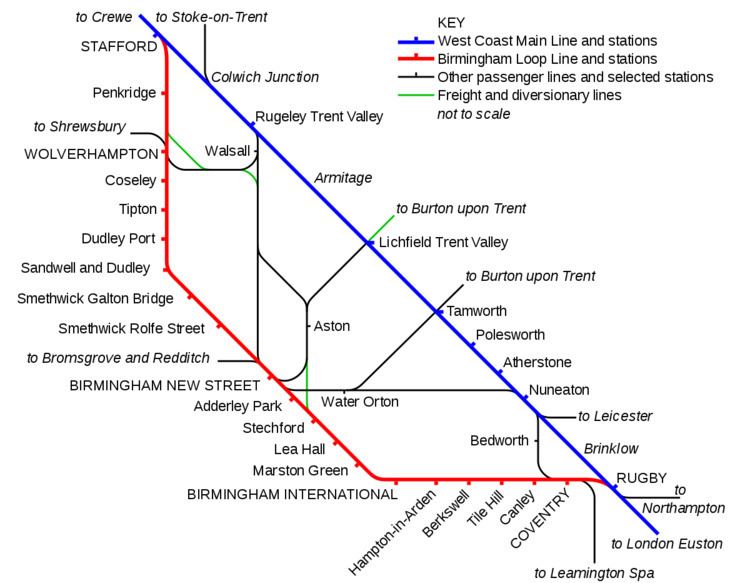Stations 21 | Opened 1852 (complete route) | |
 | ||
Track gauge 1,435 mm (4 ft 8 ⁄2 in) standard gauge | ||
The Rugby–Birmingham–Stafford line (also known as the Birmingham loop) is a railway line in the West Midlands of England. It is a loop off the West Coast Main Line (WCML) between Rugby and Stafford via the West Midlands cities of Coventry, Birmingham and Wolverhampton. The direct route between Rugby and Stafford is the Trent Valley Line.
Contents
Places served
The cities, towns and villages served by the line are listed below.
Services
A mixture of intercity, regional, cross-country and local services operate over all or parts of the route. Virgin Trains, London Midland, Arriva Trains Wales and CrossCountry all operate services.
History
The LNWR itself became part of the London, Midland and Scottish Railway (LMS) in 1923, and part of British Railways at Nationalisation in 1948.
The line was electrified along with the rest of the WCML during the late 1960s in the wake of the BR 1955 Modernisation Plan.
In 1987, British Rail commissioned artist Kevin Atherton to produce a series of sculptures to be erected along the line between Birmingham New Street station and Wolverhampton. The finished piece was titled Iron Horse, and consists of twelve different horse silhouettes, fashioned from steel. The construction material was chosen for its historic associations with the Black Country.
Many of the smaller stations on the line, were closed in the 1950s and 60s, especially between Birmingham and Wolverhampton. However, some new stations were opened in the late 20th century: Birmingham International station was opened in 1976 to serve Birmingham Airport and the National Exhibition Centre, and in 1995 another new station; Smethwick Galton Bridge was opened, serving as a two-level interchange with trains on the Birmingham Snow Hill to Worcester Line.
Accidents
Infrastructure
Despite the heavy traffic carried by the line, it is only double track throughout, and heavily congested, especially on the stretch between Coventry and Birmingham. In the 1930s, the London, Midland and Scottish Railway (LMS) started work on quadrupling the line between Coventry and Birmingham, however only preparatory work was carried out before the scheme was cancelled due to the outbreak of World War II. Periodic calls have been made since to quadruple the line between Coventry and Birmingham to ease congestion.
The line is electrified with overhead wires at 25kv AC.
